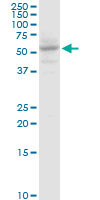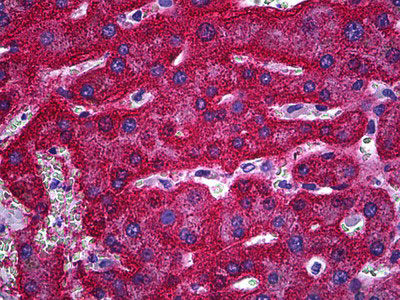SLC13A5 Antibody (clone 2G4)
Mouse Monoclonal Antibody
- SPECIFICATION
- CITATIONS
- PROTOCOLS
- BACKGROUND

Application
| WB, IHC-P, E |
|---|---|
| Primary Accession | Q86YT5 |
| Reactivity | Human |
| Host | Mouse |
| Clonality | Monoclonal |
| Clone Names | 2G4 |
| Calculated MW | 63kDa |
| Dilution | IHC-P (5 µg/ml), WB (1:500-1:1000), |
| Gene ID | 284111 |
|---|---|
| Other Names | Solute carrier family 13 member 5, Na(+)/citrate cotransporter, NaCT, Sodium-coupled citrate transporter, Sodium-dependent citrate transporter, SLC13A5, NACT |
| Target/Specificity | Human SLC13A5 |
| Reconstitution & Storage | Short term 4°C, long term aliquot and store at -20°C, avoid freeze thaw cycles. |
| Precautions | SLC13A5 Antibody (clone 2G4) is for research use only and not for use in diagnostic or therapeutic procedures. |
| Name | SLC13A5 |
|---|---|
| Synonyms | NACT |
| Function | High-affinity sodium/citrate cotransporter that mediates the entry of citrate into cells, which is a critical participant of biochemical pathways (PubMed:12445824, PubMed:26324167, PubMed:26384929, PubMed:30054523, PubMed:33597751, PubMed:12826022). May function in various metabolic processes in which citrate has a critical role such as energy production (Krebs cycle), fatty acid synthesis, cholesterol synthesis, glycolysis, and gluconeogenesis (PubMed:12826022). Transports citrate into the cell in a Na(+)- dependent manner, recognizing the trivalent form of citrate (physiological pH) rather than the divalent form (PubMed:12445824, PubMed:26324167, PubMed:26384929, PubMed:30054523, PubMed:33597751, PubMed:12826022). Can recognize succinate as a substrate, but its affinity for succinate is several fold lower than for citrate (PubMed:26324167). The stoichiometry is probably 4 Na(+) for each carboxylate, irrespective of whether the translocated substrate is divalent or trivalent, rendering the process electrogenic (PubMed:12445824, PubMed:12826022). Involved in the regulation of citrate levels in the brain (By similarity). |
| Cellular Location | Cell membrane; Multi-pass membrane protein |
| Tissue Location | Expressed most predominantly in the liver, with moderate expression detectable in the brain and testis |

Thousands of laboratories across the world have published research that depended on the performance of antibodies from Abcepta to advance their research. Check out links to articles that cite our products in major peer-reviewed journals, organized by research category.
info@abcepta.com, and receive a free "I Love Antibodies" mug.
Provided below are standard protocols that you may find useful for product applications.
Background
High-affinity sodium/citrate cotransporter that mediates citrate entry into cells. The transport process is electrogenic; it is the trivalent form of citrate rather than the divalent form that is recognized as a substrate. May facilitate the utilization of circulating citrate for the generation of metabolic energy and for the synthesis of fatty acids and cholesterol.
References
Inoue K.,et al.Biochem. Biophys. Res. Commun. 299:465-471(2002).
Ota T.,et al.Nat. Genet. 36:40-45(2004).
Zody M.C.,et al.Nature 440:1045-1049(2006).
Mural R.J.,et al.Submitted (SEP-2005) to the EMBL/GenBank/DDBJ databases.
Chen R.,et al.J. Proteome Res. 8:651-661(2009).
If you have used an Abcepta product and would like to share how it has performed, please click on the "Submit Review" button and provide the requested information. Our staff will examine and post your review and contact you if needed.
If you have any additional inquiries please email technical services at tech@abcepta.com.













 Foundational characteristics of cancer include proliferation, angiogenesis, migration, evasion of apoptosis, and cellular immortality. Find key markers for these cellular processes and antibodies to detect them.
Foundational characteristics of cancer include proliferation, angiogenesis, migration, evasion of apoptosis, and cellular immortality. Find key markers for these cellular processes and antibodies to detect them. The SUMOplot™ Analysis Program predicts and scores sumoylation sites in your protein. SUMOylation is a post-translational modification involved in various cellular processes, such as nuclear-cytosolic transport, transcriptional regulation, apoptosis, protein stability, response to stress, and progression through the cell cycle.
The SUMOplot™ Analysis Program predicts and scores sumoylation sites in your protein. SUMOylation is a post-translational modification involved in various cellular processes, such as nuclear-cytosolic transport, transcriptional regulation, apoptosis, protein stability, response to stress, and progression through the cell cycle. The Autophagy Receptor Motif Plotter predicts and scores autophagy receptor binding sites in your protein. Identifying proteins connected to this pathway is critical to understanding the role of autophagy in physiological as well as pathological processes such as development, differentiation, neurodegenerative diseases, stress, infection, and cancer.
The Autophagy Receptor Motif Plotter predicts and scores autophagy receptor binding sites in your protein. Identifying proteins connected to this pathway is critical to understanding the role of autophagy in physiological as well as pathological processes such as development, differentiation, neurodegenerative diseases, stress, infection, and cancer.



